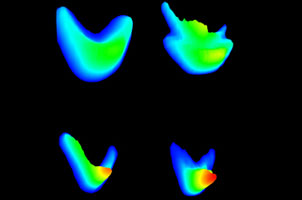| Feb 16, 2011 |
Physicists create lightest condensate from substantial particles
|
|
(Nanowerk News) In case of the Bose-Einstein-Condensation gases consisting of ultra-cold atoms change into a collective quantum state where they all have the same features. This state and the associated features are very interesting, for example, for the production of new circuits where the condensed particles flow nearly unimpeded. The problem is that the condensation with atoms only takes place in case of extremely low temperatures, rendering practical use completely impossible.
|
|
Now physicists from TU Dortmund around Dr. Marc Aßmann and Prof. Manfred Bayer and in close cooperation with colleagues from Würzburg succeeded in creating the lightest condensate from substantial particles which can in fact be used at some kelvin ("From polariton condensates to highly photonic quantum degenerate states of bosonic matter").
|
 |
| Polariton dispersions
|
|
1995 the first atomic Bose-Einstein-Condensate was demonstrated in an experiment – at extreme low temperatures below one millionth kelvin – nearly the absolute zero point. To increase the condensation temperature physicists worldwide have been trying to let the lightest possible particles condense by mixing substantial particles with light for several years. In a so-called micro-resonator new particles emerge: the polaritons. In case of such polaritons the first creation of a condensate was observed at approx. -270°C in 2006. But the price to be paid is high: the particles made to condense due to an intensive laser beam only last for a billionth second.
|
|
Together with their Würzburg colleagues the physicists from TU Dortmund have now examined what happens when the mass of polaritons is further reduced by adding more light. In doing so the life span of these particles is getting even shorter. Surprisingly there still are clear indications of condensation. Hence, the lightest currently known condensate was created in these experiments. Besides that, the physicists were able to proof the existence of so-called Boguljons which emerge in this macroscopic quantum state. Their existence also demonstrates that the condensate is a super-fluid where particles can flow without friction.
|

